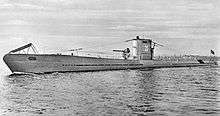German submarine U-25 (1936)
 U-25 in about 1936, (note the number on the conning tower which was removed at the beginning of the war) | |
| History | |
|---|---|
| Name: | U-25 |
| Ordered: | 17 December 1934 |
| Builder: | DeSchiMAG AG Weser Bremen |
| Yard number: | 903 |
| Laid down: | 28 June 1935 |
| Launched: | 14 February 1936 |
| Commissioned: | 6 April 1936 |
| Fate: |
|
| General characteristics [2] | |
| Displacement: |
|
| Length: | 72.39 m (237 ft 6 in) o/a |
| Beam: | 6.21 m (20 ft 4 in) o/a |
| Draught: | 4.30 m (14 ft 1 in) |
| Propulsion: |
|
| Range: |
|
| Test depth: | 200 m (660 ft) |
| Complement: | 4 officers, 39 enlisted |
| Armament: |
|
| Service record | |
| Part of: | |
| Identification codes: | M 10 950 |
| Commanders: |
|
| Operations: | Five patrols |
| Victories: | |
German submarine U-25 was one of two Type IA ocean-going submarines produced by Nazi Germany's Kriegsmarine. Constructed by DeSchiMAG AG Weser in Bremen as yard number 903, U-25 was commissioned on 6 April 1936. It experienced a short, but successful combat career, sinking eight ships and damaging one.
Service history
Until 1940, U-25 was primarily used as training vessel and for propaganda purposes by the Nazi government. During its trials it was found that the Type IA submarine was difficult to handle due to its poor stability and slow dive rate. In early 1940, the boat was called into combat duty due to the shortage of available submarines. U-25 participated in five war patrols, sinking eight ships and badly damaging one.
On 17 January 1940, 10 miles north of Shetland, U-25 torpedoed SS Polzella. Enid (Captain Wibe), of then-neutral Norway en route to Dublin, went to assist Polzella. U-25 then shelled and sank Enid. Her crew escaped in their lifeboats. None of Polzella 's crew survived.
U-25 sank eight vessels for a total of 50,255 gross register tons (GRT) and damaged one for 7,638 GRT:
Fate
Around 1 August 1940, while on a mine-laying mission near Norway, U-25 passed through British mine barrage number seven and struck a mine. The boat sank, taking all hands with it.[1]
Wolfpacks
U-25 took part in one wolfpack, namely.
- Prien (12–17 June 1940)
Summary of raiding history
| Date | Name of Ship | Nationality | Tonnage[Note 1] | Fate[3] |
|---|---|---|---|---|
| 31 October 1939 | Baoulé | 5,874 | Sunk | |
| 17 January 1940 | Enid | 1,140 | Sunk | |
| 17 January 1940 | Polzella | 4,751 | Sunk | |
| 18 January 1940 | Pajala | 6,873 | Sunk | |
| 22 January 1940 | Songa | 2,589 | Sunk | |
| 3 February 1940 | Armanistan | 6,805 | Sunk | |
| 13 February 1940 | Chastine Mærsk | 5,177 | Sunk | |
| 13 June 1940 | HMS Scotstoun | 17,046 | Sunk | |
| 19 June 1940 | Brumaire | 7,638 | Damaged |
References
Notes
- ↑ Merchant ship tonnages are in gross register tons. Military vessels are listed by tons displacement.
Citations
- 1 2 Helgason, Guðmundur. "The Type IA boat U-25". German U-boats of WWII - uboat.net. Retrieved 29 December 2014.
- ↑ Gröner 1991, p. 39.
- ↑ Helgason, Guðmundur. "Ships hit by U-25". German U-boats of WWII - uboat.net.
Bibliography
- Busch, Rainer; Röll, Hans-Joachim (1999). German U-boat commanders of World War II : a biographical dictionary. Translated by Brooks, Geoffrey. London, Annapolis, Md: Greenhill Books, Naval Institute Press. ISBN 1-55750-186-6.
- Busch, Rainer; Röll, Hans-Joachim (1999). Deutsche U-Boot-Verluste von September 1939 bis Mai 1945 [German U-boat losses from September 1939 to May 1945]. Der U-Boot-Krieg (in German). IV. Hamburg, Berlin, Bonn: Mittler. ISBN 3-8132-0514-2.
- Gröner, Erich; Jung, Dieter; Maass, Martin (1991). U-boats and Mine Warfare Vessels. German Warships 1815–1945. 2. Translated by Thomas, Keith; Magowan, Rachel. London: Conway Maritime Press. ISBN 0-85177-593-4.
- Williamson, Gordon (2005). Wolf Pack: The Story of the U-Boat in World War II. Osprey.
External links
- Helgason, Guðmundur. "The Type IA boat U25". German U-boats of WWII - uboat.net. Retrieved 6 December 2014.
- Hofmann, Markus. "U 25". Deutsche U-Boote 1935-1945 - u-boot-archiv.de (in German). Retrieved 2014-12-06.
Coordinates: 54°14′N 5°7′E / 54.233°N 5.117°E